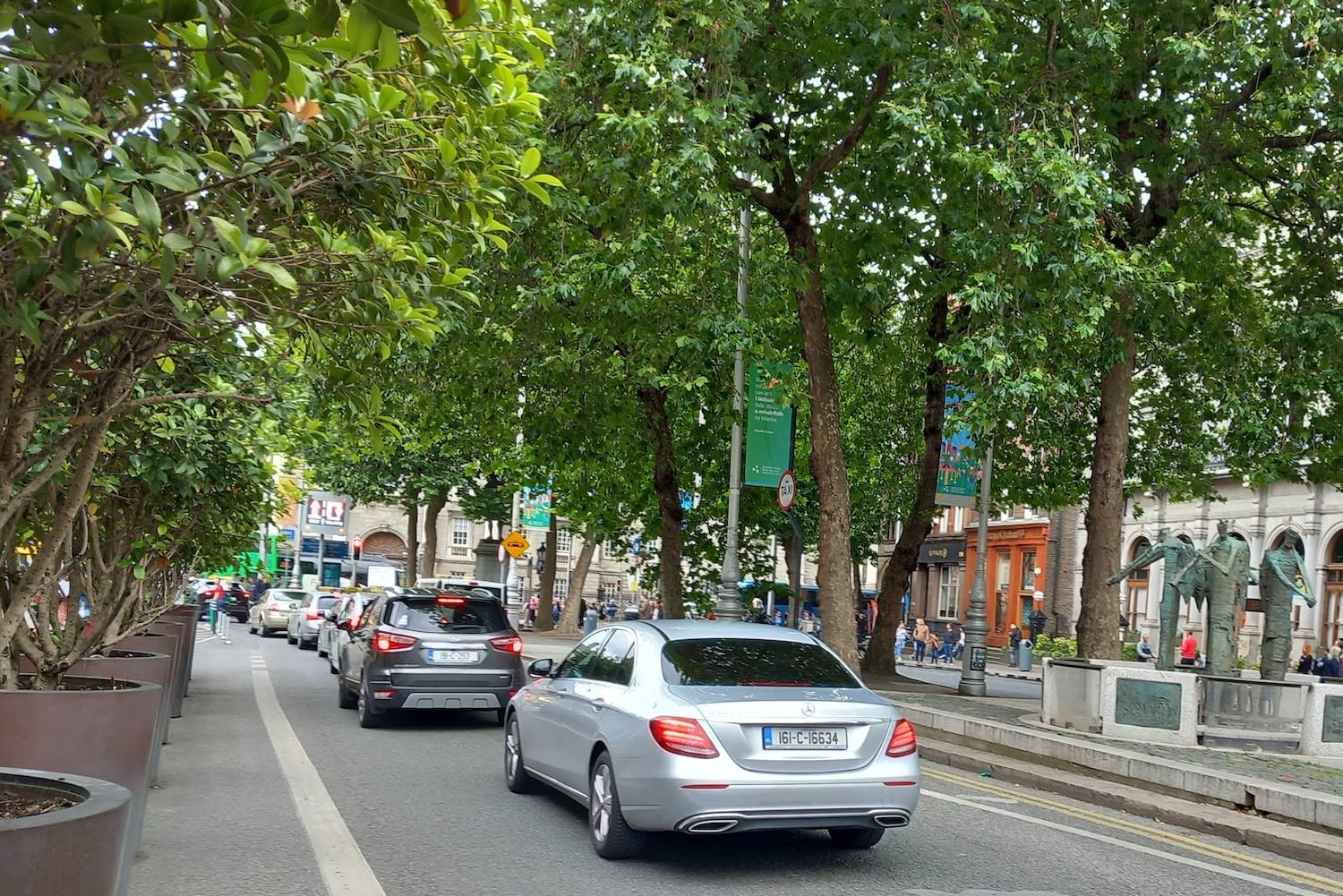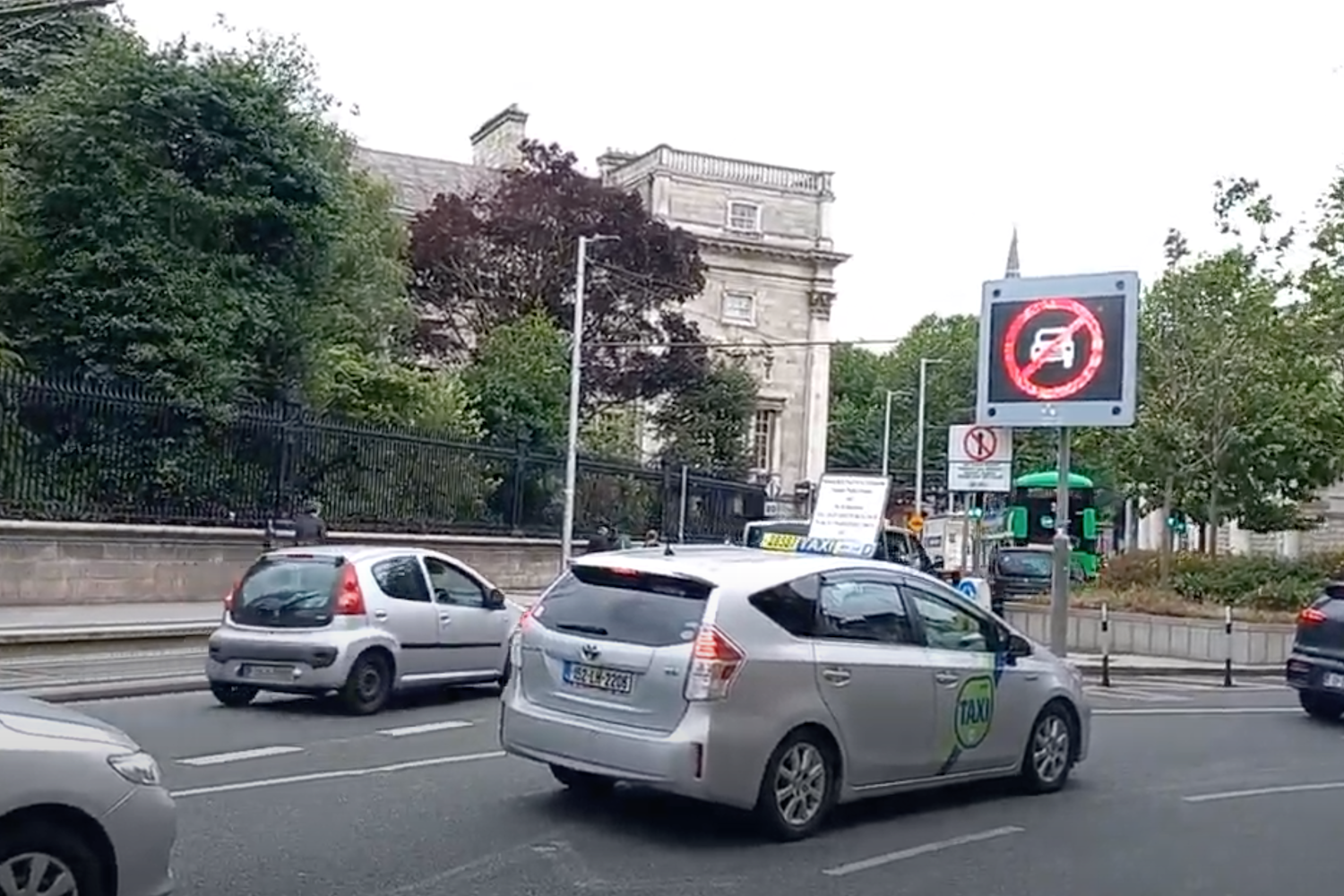What’s the best way to tell area residents about plans for a new asylum shelter nearby?
The government should tell communities directly about plans for new asylum shelters, some activists and politicians say.
A council official said it was up to Gardaí to enforce the 24/7 ban. Gardaí have not responded to queries about what they’re doing to enforce it.

On Thursday, in 20 minutes, at least a dozen drivers zipped through College Green who shouldn’t have.
Since 29 May, only drivers of certain types of vehicles have been allowed through this major artery, 24/7.
It’s just buses, taxis, and “local access” – people driving to somewhere within College Green, rather than passing through it to get somewhere else.
But between 11.40am and 12 on Thursday morning, a whole procession of private and business vehicles that were not taxis or buses passed through without stopping.
A gold sedan, a silver Mercedes, a slate-coloured SUV, a white PaperPunch office supplies van, a black minibus with tinted windows. They all went east past the front of the Bank of Ireland.
A Garda car zipped through in the midst of all this and continued on its way. A Dublin City Council water services van zipped through not long after that.
Vehicles broke through restrictions coming west into College Green too, via Pearse Street. To do so, they passed a giant illuminated sign saying “College Green bus corridor public transport only 24/7”, within sight of the Pearse Street Garda Station.
There was a big white truck with “jjmahons.com” on the side. A little silver hatchback came through just seconds later.
Given that the restrictions have been now extended to 24/7, “it should be far easier to enforce” them, said Fine Gael Councillor Paddy McCartan at July’s monthly meeting of Dublin City Council.
And yet “I have visited the site at various times and I still see private vehicles entering the particular corridor”, McCartan said.
Marius Treciokas, eating his lunch on Friday in the driver’s seat of his van, parked on Church Lane, gave a simple explanation as to the law-breaking. “I’d say they don’t want to waste time and just take a chance.”
“Why not?” asks Anthony Turner, a taxi driver parked on Foster Place the same day. “Nothing’ll happen to them.”
Even up until the end of May, private through-traffic had been barred from College Green from Monday to Friday, between 7am and 7pm.
Each week, 2 million passengers on public transport go through College Green, compared to 27,000 private vehicles, said the council’s chief executive recently, in a written response to a query from independent Councillor Nial Ring.
“However, this small number of private vehicles causes significant delays to public transport journey times in the area, particularly in the evenings and at weekends when there are no restrictions,” the response said.

Extending restrictions was part of a larger set of changes the council is making on College Green to “help alleviate public transport congestion in the city core, prioritising public transport at all times”, the response said.
Clearing private-vehicle traffic out of bus lanes is key to making the BusConnects redesign of the city’s bus networks operate smoothly. Barring more vehicles from College Green is also a step towards a longer-term plan for a pedestrian plaza there – for which the council is in the midst of choosing a design team.
People driving to the businesses within the restricted area, of course, are not barred. For example, on Thursday, a grey-haired man drove into College Green from the west, into the courtyard of the Bank of Ireland, and parked near the doors, and walked in.
However, many vehicles that aren’t going to local businesses still pass through the area, breaking the restrictions.
All the extra vehicles that shouldn’t be passing through, each usually with a lone driver at the wheel, slow up the rivers of buses plying their routes, says Thomas O’Connor, assistant general secretary of the National Bus and Rail Union (NBRU).
Especially after 7pm, O’Connor says. That’s when the traffic light sequences change to give more priority to pedestrians and less to motor-vehicle traffic, and College Green becomes a real bottleneck, he says.
And when people find public transport frustratingly slow to use, they are more likely to drive cars – meaning more traffic congestion, more pollution, more carbon emissions.
Bus drivers are frustrated that Gardaí don’t do more to punish drivers of private vehicles passing through College Green – and, more broadly, drivers using bus lanes all over the city, says O’Connor, of the NBRU.
It’s not just the bus drivers who are frustrated.
“When you ask Dublin City Council about enforcement, they say it’s a matter for the Gardaí, when you ask the Gardaí they don’t seem to make any comment,” said McCartan, the Fine Gael Councillor, at July’s monthly meeting.
Council senior engineer Patricia Reidy responded to McCartan’s concern.
“It is frustrating when you hear, you know, that enforcement is a matter for An Garda Siochana, but they are the correct people with the powers to enforce,” Reidy said.
“I, certainly … we are liaising with them and we can ask for more of an increased presence if you have noticed a lot of private cars still there,” she said.
Before the restrictions were extended 24/7, about 8,500 private vehicles a week were going through College Green during the hours they were prohibited from doing so, according to the chief executive’s response to Ring, the independent councillor.
Gardaí did not respond to queries sent Thursday about what it was doing to enforce the restrictions, and whether it could do more.

The temptation to drive right through College Green is high, says Treciokas, eating his lunch in the driver’s seat of his pest-control van on Friday.
“If you want to go to Townsend Street, you’d have to go all the way across the river and back,” he says. “It could take an extra half hour.”
On Monday morning, about 10am, Google Maps says the trip would take three minutes by bike to get to the near end of Townsend Street, a quick 400m glide directly through College Green.
But for cars, it directs drivers south through narrow streets, around College Green, past Merrion Square, and around the back of Trinity College, up to the quays, then back south along D’Olier Street: nearly 4km, about 20 minutes.
Treciokas says the signs explaining that this isn’t allowed are numerous, and prominent enough: “They’re quite visible.” And he’s seen Gardaí enforcing the restrictions.
But the temptation is high and enforcement is rare, he says.
O’Connor, of the NBRU, says if Gardaí’s time is better used dealing with anti-social behaviour or other more pressing issues, there’s been talk of using footage from the cameras in front of buses to fine drivers who use bus lanes when they shouldn’t.
“It’d save actually having to use Gardaí resources,” he says. This is something the council has looked at, running a related pilot in 2020–2021.
The government has long said it plans to bring in camera-based enforcement of road traffic laws.
At the moment, there’s a National Transport Authority-led government task force that is supposed “to assess and make recommendations in relation to the further extension of camera-based enforcement”.
Its chair said in May that the working group would report back by the end of this year.